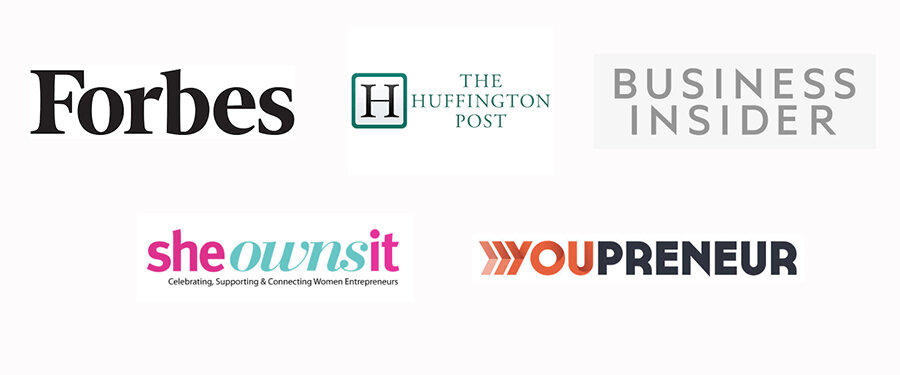
Build a High-Functioning, Profit-Generating
Is Your Business Aligned with Your Purpose?
As featured in:

DOWNLOAD [FREE] QUIZ CREATION 10-STEP BLUEPRINT
Are you looking for ways to avoid wasting time, money and energy while creating a one-of-a-kind quiz that work for your business 24/7 collecting relevant email addresses on autopilot?
Then you just found the solution!
Download this battle-tested 10-Step Blueprint that will keep you from overthinking. Just follow the steps exactly the way it shows.

“Life is really simple, but we insist on making it complicated.”
Have you ever looked at your business like a living organism, similar to a pet you absolutely adore or your child that you unconditionally love?
In today’s post, I want to talk about the importance of this idea and how to implement it.
Before getting started, I want to clarify something so that there won’t be any misunderstanding between us.
In the past, I’ve written about how your business is not your baby. I still stand firm by what I’ve said. You might be thinking, “So, what changed?”
My answer is…nothing.
Bear with me for a few more seconds. Here is what I mean by it.
I’ve seen many business owners who’ve shouted, “But…but my business is my baby!” to defend their shortcomings, limiting beliefs or wrongdoing.
They were using it as an excuse to say they know what’s best for their business, but in reality, they were so off the mark, not to mention they could’ve used some help.
In that regard, I am not changing my stance about how “Your business is not your baby.”
But I am not saying that you should not love your business.
On the contrary, I am advocating for loving & nurturing your business in the most genuine way, so that it will grow the way you envisioned.
Building a healthy relationship with your business is a way to enhance your well-being while maximizing your business’ growth potential.
One way, or dare I say, the only way, to do it is to love & nurture your business like a living & breathing thing.
If you happen to be a logical thinker like me, you might not see the point of this.
Truth be told, what I am about to share isn’t something I always believed. I started to pay more attention to this not so long ago.
My hunch is that you reading this now is an indication that there is something about it that you’re resonating with.
If so, I’m delighted that you are willing to give this post a chance.
Today, I am delighted to introduce Zahra Yarahmadi, the founder of BG Financial Consulting Group, specializing in pricing strategies and revenue optimization for B2B SaaS startups.
This is a new series I am creating inside my blog to bring trailblazing founders, entrepreneurs, and service business pros to you so that not only you get a dose of inspiration but also be exposed to real-life strategies that the guests implemented to grow their businesses.
I met Zahra through a business community and found her niche intriguing. Although she is well versed in all things financial management, she made a decision to strategically position herself to be the go-to for SaaS pricing and revenue optimization.
This led me to reach out to her for her insights on her profitable niche.
My hope for this post is for you to get inspired by her journey and incorporate some of the ideas into your niching strategy.
So, let’s dive in!
*Disclosure: I am an affiliate of the quiz creation platform, Interact. While this partnership gives you the chance to take advantage of a discount upon signing up with them, I also get a cut directly from Interact.
#TrueStory – I had resisted creating a quiz to promote my business for the longest time.
I thought it was too gimmicky for my brand, as I wasn’t about to create a, “What’s Your Spirit Animal?” quiz. I thought the quiz craze was going to quickly die down. I thought it was just another flavor of the month that I didn’t need to give my attention to.
So, I warned myself not to jump on this bandwagon only to end up as another case study for allowing shiny object syndrome to side-track me from my vision for the business.
The reason I finally convinced myself to give it a try was when I gained clarity on the benefits of doing so. I realized that a free quiz could potentially serve more than the one purpose of building my email list on autopilot.
Little did I know that starting on my quiz creation journey was going to be one of the few best decisions I’ve made for my business.
By the way, I call this a “journey” because it took me a long time to finish it.
Wait, don’t bounce just yet because I said it took a long time. It’s not that it took me a long time to work on creating a quiz day in & day out. It took me a long time because I had to walk away from this for a few good months before I came back to finish it.
Actually, believe it or not, I walked away from both of my quizzes.
Yep, I have 2 quizzes, and I had to walk away from both of them. For the first one, it took me more than 5 months to revisit it. The second one took me a lot less time, about 2 months or so.
But the good news is that you don’t have to go through the same journey.
Let me share a heartbreaking story that fueled me to write this piece. It goes like this:
"Guys listen, to be perfectly honest with you, I'm shocked,” said a bright young YouTuber during one of his live streams where more than 4,000 people were watching in real time.
He continued, "I've given you all the free tools. I've given you short educational videos. But most of you watching this right now don't even use them. I know this because I check the analytics."
He was clearly upset & disappointed, but not because his viewers weren’t buying anything from him. He only provides free content on YouTube.
"You guys are just waiting for me to save the day. If things don't go your way, you just shit-talk in the comments. All you want to know is whether this coin is a buy or that coin is a buy."
"I decided to start this channel (that I'm contributing to) to help people generate ‘generational wealth.’ That's my mission. I don't need to do this for a living. I don't need to do this if you aren't serious & committed."
I genuinely felt for him. I knew exactly how he was feeling.
Here's a quick backstory about this guy.
He's 25 years young. He lost his father to suicide last year. He was barely making ends meet with his construction business. Then he got scammed & lost all of his money in the crypto market.
He only had $400 left to his name & he went back to work to learn how to trade the right way. From scratch.
He stopped watching TV. He cut down on spending time with his family & friends. He was determined to make it work.
And, he made it work.
Let me guess. You’re here checking this post out because you’ve heard of the expression, “The riches are in the niches,” or you might have heard someone say, “You have to nail your niche. Appealing to everything is appealing to no one.”
You sort of get why business experts say these things, but you are still a bit skeptical as to how this can be applied to your service business.
Then, this post is perfect for you!
If you are new to me or my business, you may not know this, but I’ve written a few posts about why finding your profitable niche is important and how to go about it.
For this post, though, I wanted to take a completely different approach. The reason is this:
What I have come to realize by helping entrepreneurs find their profitable niches in my business is that no amount of information about the importance of niching down will help if their minds are already fixed on resisting this concept due to their limiting beliefs.
Here, you will learn about 9 common myths among entrepreneurs that cause stagnation in their business growth. In other words, they force entrepreneurs to take a longer route to scale their businesses.
While you go through these 9 myths, I want you to ask yourself if any of these describe your impression on the concept of niching down. Understanding why you might feel this way & what the solutions are to shifting your thinking is the first step on the path of finding your profitable niche.
My goal for this post is to help you remove all of the doubts & resistance you have about niching down so that you can grow your business faster by finally being ready to try this effective way of positioning your business in the sweet spot.
After reading this post, if you feel super excited about taking a fresh look at your business, then I can safely say I’ve done my job!
Keep in mind, whatever I share with you in this post comes from my own experience and from the work I do with service business owners. These are not just theories; these are real life examples.
This is a tale of a crime that you must know as a service business owner.
This is a crime I have knowingly committed in the past, and I am coming clean about right here, right now.
Whether you’re aware or unaware, if you end up identifying with what I am about to share, you must also come clean for the sake of your business and your customers.
It’s funny how this is NOT often discussed as a "crime." But I'm calling it a crime because it's not the way to run a sustainable business.
So, what is it, you might ask?
Well... Let me tell you a story & give a few examples.
Once upon a time, my main business model was a monthly retainer model. Before that, I was charging hourly.
I thought, "I made progress!" Charging a flat rate on a monthly basis made me feel like a badass. In case you are still charging hourly for your service, check out “Still Trading Time for Money? Overcome These 5 Key Hurdles & Finally Stop Charging By the Hour”
But soon after, I started to question this model.
I thought, "Wait, there's only so many clients I can take on. And my sales cycle for getting them is long. The only way to keep going would be to make sure that I keep my current ones as long as possible."
Do you know exactly what I was thinking of as a “quick solution”?
I'll give you a min. I want you to think about what my immediate solution was.
OK, so my thinking was:
I’m glad you found me here because I’m about to make a bold statement. Are you ready?
This year would be so much worse if it weren’t for
the Word of the Year that I chose to live by.
About a year ago, I brainstormed my Word of the Year for this year not knowing what was in store for us, more specifically, how CRAZY this year was going to be for most of us regardless of where we are located.
Yet, the word I chose was just perfect for this year.
If you are interested in understanding why this matters & how I go about choosing the word that helps me grow as a person and moves my business forward, do check out How to Pick Your Perfect Word of the Year that Will Help You Finally Achieve Your Massive Business Goals in the New Year.
As I said in this post, this is not some kind of cute exercise to do to make you feel like you are doing something. On the contrary, if you take this seriously, you are going to produce the results that you want.
In order to produce results, you want to experience as many breakthroughs as possible. When I say “experience breakthroughs,” I don’t mean for you to sit back and experience them. That’s not how it works.
Instead, what you want is to induce breakthroughs by doing things that you’ve never done before faster and more often. By having your Word of the Year in place, it will help you get through the fear of trying something new and/or resistance to sticking with it.
I don’t know what your year looked like or how hard or easy it was for you, but if you are here because you know you can be unstoppable in achieving great things and you are more than ready for the new year, this is for you.
In this post, I’m going to share my experience using my Word of the Year, “Limitless” and what I took away from it. Then I’m also going to share the stories of 2 fabulous guests I had on my monthly Business Therapy Hour on how they choose their Word of the Year.
Oooo, let me tell you how much I dislike getting my photo taken. I’ve dodged it very cleverly for the longest time…4 years to be exact. So why did I book a proper branded photoshoot a.k.a. a “branded lifestyle photoshoot?” Well, you’ll find out all about it in this post.
But you might be saying, “Hey Maiko, I’ve seen your photos all over the place. What do you mean you’ve been dodging it?”
Did I not just say I’ve been “cleverly” dodging it? I’ve had 2 very casual shoots done by my friends in the past, just so that I didn’t get too nervous & worked up about the whole thing. Then while I was using some of them, I hired photographers to shoot my live events for “candid shots.”
Candid shots are great because I don’t need to pay attention to what the photographers are doing. I let them do their thing & voila! A ton of good photos come out of nowhere. Then I picked a few & threw them up on my website.
These are a couple of clever ways to avoid a proper photoshoot.
But there comes a time when you want to buckle down (more like suck up) and do one.
I see you. I see your disappointed, exhausted face after cranking out content after content. For free.
You consider yourself a hardworking and good student of marketing, and you know that getting your business off the ground by just relying on word-of-mouth isn’t sustainable.
So, you tune into podcasts, read up on articles and follow experts on social media to see what they suggest and what they are doing. It won’t take long before you learn it’s all about “giving away the best stuff” and “engage, engage, and engage” long before making an offer.
You roll up your sleeves and start creating content even though the process is scary and uncomfortable. You press on by navigating through fear of judgment, imposter syndrome, the dreaded feeling of how you look on camera…(or how much you hate your own voice). You are a trooper.
But…the problem is…it’s not working. You aren’t getting any traction, let alone inquiries for hiring your business. You wonder, “What am I doing wrong?! I’m grinding myself into the ground by creating content!”
You find yourself feeling resentful. Your brain is fried to the point where it’s crispy. You are on the edge of giving it all up.
The good news - You are here. The bad news - I’m going to tell you that you have been somewhat misinformed. But I won’t just leave you there. I am going to tell you what to do. So, I think that’s still good news.
Just to be clear, the advice of “giving away the best stuff,” and “engage & don’t sell” isn’t wrong. What’s wrong is your understanding of doing that at which stage of your business and for whom. This, in my strong opinion, is not explained well enough by those experts. We’ll get into that in a minute.
Now take a deep breath & stop whining. We have work to do.

“Our video production business was growing rapidly, so much so that we became too busy to keep up with the demand. We knew we needed to strengthen the backbone of our business to maintain the quality of our work.
Maiko provided a system we can follow to build a sustainable business. With what we learned from working with her and the BO360 system, our second business took off with less than half of the time we spent on our first business!
Zahira & Fernando Ortega, Faro Films / Chosen Posture / The Garden of Virtues
”












Back in December 2019, I was completely burned out - to the point where I felt crispy inside, like there was zero moisture (energy) left.
I jokingly say that now to be funny (in my own way), but it wasn’t funny back then.
For three years leading up to that point, I had been building my community through in-person events in New York City while cranking out long-form blog content online.
Planning and promoting my events, writing blogs and promoting those, occasional podcast guesting, and other PR activities (because I couldn’t be consistent) … all of it was draining me while I was also servicing existing clients.
I had an editor, an assistant, and a small part-time event team—yet all the key tasks still fell on me.
Looking back, the biggest cause of my burnout was that I had no good results to show for it.
I kept going for a while, knowing this was a long game and consistency mattered.
But at some point, I could clearly visualize myself standing at a crossroads:
“Should I keep going to become an overnight sensation that was 10 years in the making… or switch to DSD - do something different?”
Anytime I feel the need to regroup, the first place I start is by reassessing my why.
So… why was I doing all these activities in the first place?
It wasn’t simply about getting more clients.
My goal was to move away from referral dependency.
I knew relying solely on referrals and word-of-mouth wasn’t a sustainable business development model for my business.
I had chosen to do in-person events and blogging to build my email list and nurture my leads through my email newsletter.
But the reality? It was painfully slow.
At the end of 2019, I had fewer than 250 people on my email list.
Although my blog posts were gaining popularity - thanks to their unusual yet relatable business topics - only a handful of clients came directly from learning about my services through my blog.
I was tired. I felt defeated. And worse, I could sense a feeling of resentment gradually brewing inside me.